|
|
| |
|
 | Search: |
|
|
|
|
|
 |
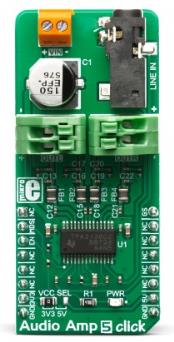
|
|
Audio Amp 5 Click is a stereo audio amplifier, capable of delivering up to 10W per channel with the 8? load. It is based on the TPA3138D2, a class-D integrated amplifier, which utilizes a highly efficient switching scheme. With about 20mA in idle mode, it allows for longer operation and improved thermal performance, making it a perfect choice for various battery-powered applications. Advanced EMI Suppression with Spread Spectrum Control allows using ferrite bead filters instead of bulky inductors, still maintaining the required EMC levels. The TPA3138D2 IC is equipped with a set of protection features, allowing a reliable operation.
Audio Amp 5 Click is supported by a mikroSDK compliant library, which includes functions that simplify software development. This Click board™ comes as a fully tested product, ready to be used on a system equipped with the mikroBUS™ socket.
|
|
|
|
|
 |

|
|
AudioAmp click is a mikroBUS add-on board that functions as a mono audio amplifier. It is driven by a Texas Instruments LM48100Q-Q1 Boomer Mono, 1.3W Audio Power Amplifier IC.
AudioAmp click has one 3.5 mm input jack and next to it screw terminals for connecting output wires to a passive speaker. It has dual audio inputs that can be mixed/multiplexed to the device output. Each input path has its own independent, 32-step volume control. The mixer, volume control and device mode selection are controlled through the mikroBUS I2C interface.
Fault detection is another important feature of LM48100Q. It senses the load conditions, protecting the device during short circuit events, as well as detecting open circuit conditions.
AudioAmp click can work either on a 3.3V or a 5V power supply. There's an additional jumper for selecting the I2C address as well. The open-drain output fault flag. FAULT is routed through the default mikroBUS INT pin (0 indicates that a fault condition has occurred). |
|
|
|
 |
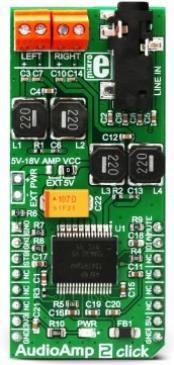
|
|
Audio Amp 2 click is a highly efficient class D audio amplifier, using the TDA7491, a dual BTL class-D audio amplifier IC, capable of delivering up to 20W to 8? load. This amplifier IC features high-efficiency output stage drivers and clever design, allowing it to deliver a reasonably high power to the connected speakers, using only GND polygon on the PCB for heat dissipation. In the BTL topology, the output DC blocking capacitors are not required. This allows for simpler design and lower power losses, especially with no input signal. The TDA7491 amplifier IC is equipped with a set of protection features, that allow reliable operation. |
|
|
|
 |
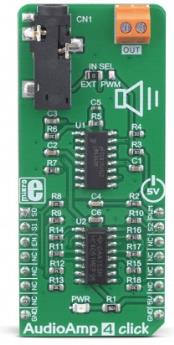
|
|
AudioAmp 4 click is a low-power audio amplifier with a digital volume control. It is equipped with the LM4860, an audio amplifier IC capable of delivering up to 1W of continuous power to an 8 O load. It has a very low total harmonic distortion (THD) of less than 1% over the entire audio spectrum, which makes it perfectly suited for small boom-boxes, PC speakers, and similar low-power sound reinforcing devices that can be powered by batteries. A high integration level of the LM4860 IC allows an additional circuit for digital signal attenuation to be used, offering 8 different volume levels, selectable over 3 GPIO pins of the mikroBUS™.
AudioAmp 4 click is supported by the mikroSDK compliant library, which includes functions that simplify software development. The Click board™ comes as a fully tested product, ready to be used on a system equipped with the mikroBUS™ slot.
|
|
|
|
 |
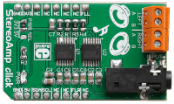
|
|
StereoAmp click functions as a stereo amplifier and is ideal for battery operated devices or as a lab amplifier. It features two LM48100Q-Q1 Boomer single supply, mono, bridge-tied load amplifier ICs by Texas Instruments. The LM48100Q-Q1 has output fault detection and I2C volume control.
The StereoAmp click features a 3.5mm input jack and four output screw terminals for connecting passive speakers. It runs on either 3.3V or 5V power supply and communicates with the MCU through the I2C interface. |
|
|
|
 |

|
|
2x5W AMP click functions as an amplifier and features the TDA7491LP 2x5-watt dual BTL class-D audio amplifier. The click is designed to run on either 3.3V or 5V power supply. It communicates with the target MCU over the following pins on the mikroBUS™ line: AN, RST, CS, PWM, INT. |
|
|
|
 |
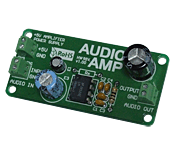
|
|
The AudioAMP Board features an on-board power amplifier LM386 designed for use in low voltage consumer applications. The quiescent power drain is only 24 milliwatts. The board can be connected to your prototype device via on-board screw terminals. |
|
|
|
 |
|
|

